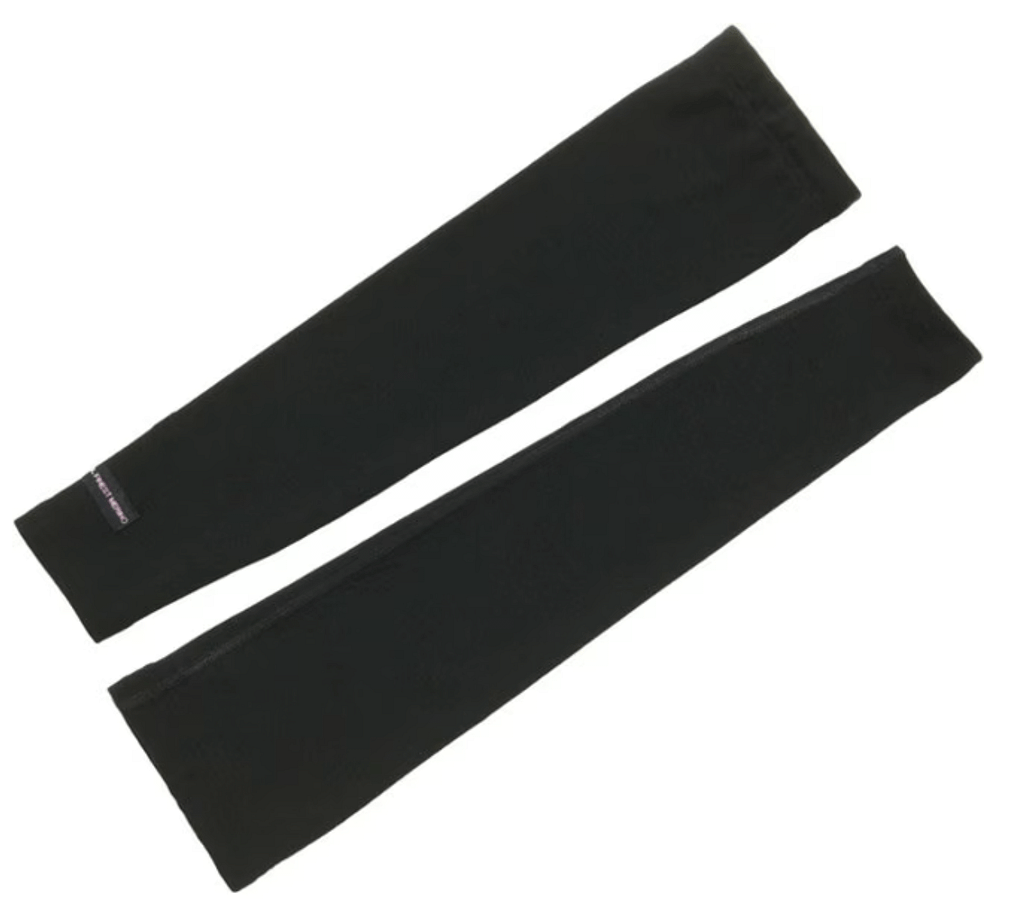This is a continuation of a series on how I learned to actually enjoy hiking in cold weather. The keys are: Mindset, Preparation, and Clothing. The post on clothing discussed fabric choices and layers. This post is a compilation of creative ways to fine tune those layers in order to micromanage sweat.
The Challenge
While hiking the hills and mountains of the Southeast in the cooler seasons, both the temperatures and our exertion levels can change drastically and frequently.
We sweat going uphill but not so much going downhill. Clouds will often accumulate on the northern and western slopes before spilling over the top. Therefore the northern and western sides are generally wetter, windier, and colder. Trails on one side of a mountain will cross to the other side and back again within a short distance; some flip back and forth for miles. While the ridges are generally windy, the lower elevations can be quite sheltered and calm. And any time we stop for a snack or to enjoy a view, our bodies begin to cool quickly.
All of this makes managing moisture a little challenging.
Adding and removing layers frequently is crucial to proper heat and moisture management, but that’s not always as easy as it sounds. Hats and gloves can be stashed in pockets – if pockets are available – while continuing hiking. However most layers require that we stop hiking before they can be changed.
For example, any time we add or remove a jacket, we must take off the backpack. An experienced thru-hiker might be able to do this while walking – depending on the terrain. But that is not something most day hikers would be comfortable doing.
Adding or removing bottom layers can take even longer. Most pants will require removing the boots first. Even if they can be put on while wearing shoes, mud from the shoes will transfer to the inside of the pant legs. Yuck! And then there are fleece-lined tights worn under pants. There is no way to add or remove those modestly – so we suffer for a while before finally going off-trail to hide behind a tree or an umbrella.
We Are Here To Hike
No matter whether we hike slow or fast, these stops detract from the hiking experience. We came to hike and enjoy nature, not to stand on the trail and add or remove layers. Nor do we want to break our momentum. If we are going to stop, we want it to be for something like taking a picture or catching our breath, not changing clothes.
The longer it takes to remove a layer and stash it securely, the longer we will delay stopping to remove it. “I can tough it out for a bit,” we tell ourselves. That causes us to sweat more. And as a result our bodies get colder. That can be uncomfortable at best or dangerous at worst.
This pressure to keep going is compounded when hiking with a group. With more people, the stops can increase in number and in duration. Again, we are not in a race, but our fellow hikers begin to cool off while waiting. We want to be courteous and so we minimize unnecessary stops and keep them relatively short.
So, what is a day hiker to do? I suggest ‘modular clothing systems’.
Modular Clothing Systems
What is a modular clothing system? It is a set of clothing and accessories designed to work together to keep us comfortable in the varying conditions on trail while simultaneously minimizing the time spent adding and removing the layers. It often includes articles of clothing which are extremely easy to put on or take off as well as items which have multiple functions. If they are small enough to stash in a pocket while we continue walking, that is even better!
This is not a new concept at all. Historically, we find all sorts of examples of practical clothing and which could be worn, carried, or adjusted to accommodate an individual’s needs. Medieval dresses had detachable sleeves; men’s hose were basically long leg warmers tied to a belt. The Scottish great kilt could be arranged in various ways to allow maximum ventilation or maximum protection.
So with this idea in mind, here are some options you might want to consider adding to your hiking clothing system to help you micromanage sweat and minimize stops.
**Frugal mom tip: These items can help extend the hiking wardrobes of growing children.
[Disclaimer: The links below are NOT affiliate links. Not one. I have done business with some of the companies. However I do not own any of the products shown or linked here. I offer them simply as examples of the possibilities.]
Upper Body
Sleeves
Detachable sleeves/arm warmers/arm gaiters are popular, particularly in the biking community. For hikers, they offer great ventilation in the underarm area while also eliminating the need to remove a pack to add a layer. Different fabrics will protect against sun, cold, and/or rain. Water resistant or waterproof sleeves can be used with a poncho to better protect one’s arms.

JacksRBetter makes down sleeves which would be an option for more extreme conditions. Remember that down loses all its insulating properties when wet – whether that is from sweat or rain/fog.
REI has a few options, but be sure to check your favorite bike shop or other outdoor retailer.

For those who prefer to DIY their gear, a trip to the thrift store can yield plenty of options. Choose a shirt or jacket in a fabric you prefer. Cut off the sleeves. Finish the edges by hand or machine. You may want to add a bit of elastic at the top, a fastener which attaches to your shirt sleeves, or a strap such as the one on the Jacks R Better down sleeves. Voila! You have custom arm warmers to layer under or over your other pieces of clothing.
Check out The Rambling Hemlock for an example of DIY sleeves/arm gaiters.

Jacket Fronts

For more coverage, Dutchware Gear offers the Fracket.
The basic concept here is that since a pack offers plenty of insulation for the back, there is no need to add more insulation to that area. The Fracket covers the arms, sides, and front while fastening around the neck and waist.
To DIY this, one could simply wear a zippered jacket backwards. However that would likely be a little more cumbersome in the neck and chest area as jackets are not designed to be worn this way. For a short stint on the cold side of a mountain or a quick way to keep warm during a break, this is something to keep in mind.
Also consider a shemagh or similarly-sized wool kerchief. In addition to functioning as a scarf or head warmer, these can be draped across the front of the body to provide just a little more insulation to that area. A kerchief combined with arm gaiters and a backpack would be the ultimate in lightweight versatility and ventable warmth.

Check out this video with 30 uses for a wool kerchief.

Neck Gaiters
A neck gaiter or buff is highly versatile, easily added or removed, and is surprisingly effective in helping regulate body temperature.
Ponchos
And the ultimate in flexibility and versatility is the poncho. If you can get past the unfashionable, hunchback look, rain ponchos are great. We can put them on or take them off without ever removing a pack and provide protection for that pack. They offer ventilation better than any pit zips. A belt reduces flapping in windy conditions. A poncho can also function as an emergency shelter.
Lower Body
Even for the lower body, there are plenty of modular, easily removable options. Of course, most people find that they need fewer layers on the legs than the arms when hiking.
Leg Gaiters
Leg gaiters are common. Short or long, insulated or not – gaiters can prevent rocks, sand, and rain from falling into shoes as well as protect legs from bugs, sun, wind, and cold. Some styles and brands are easier to remove than others. Many are designed to be pushed down to the ankles instead.
REI offers a helpful article on choosing the right gaiters for you.


And again it is possibly to DIY your own leg gaiters. Rambling Hemlock made these.
Similar to leg gaiters, leg warmers are an option in cooler weather. Wear the knitted varieties beneath pant legs to prevent snags. Or wear them over pants and cover them with water repellant leg gaiters in cold, wet weather. These are a little more difficult to remove and would most likely be pushed down to the ankles until you are ready for a slightly longer stop.
Skirts/Kilts
For the most versatility and breathability, I highly recommend skirts or kilts. Again, these come in a myriad of styles and designs.
Over the last several years, skirts as a primary layer (in lieu of shorts or pants) have gained in popularity within the hiking community due to their general flexibility and excellent ventilation (which reduces chafing for many). Women like them for the ability to relieve themselves without baring all.
Baselayers
As a base layer, there are MANY brand options. Here are two.

Voormi offers a merino wool skirt.
PR Adventure Skirts (formerly Purple Rain Skirts) offers skirts and dresses made of synthetic materials

And for the DIY-er, Rambling Hemlock has some helpful tips with three versions of hiking skirts. I referred to her site when sewing my own hiking skirts from thrifted pants.
Insulation/Shell Layers
Rain kilts have become popular with both men and women because they offer protection from rain and wind while also allowing excellent ventilation. Don them over pants or shorts eliminating the need to remove one’s boots. Combine them with gaiters for full leg protection

Dutchware Gear offers a simple rain kilt.
Lightheart Gear offers one that is a little more feminine.

In winter months, many women have discovered that skirts are easy to put on over boots and pants for a little extra warmth and rain/wind protection – even when simply walking the dog or running errands.
Or there is this option at REI.

Piecing It Together
There are a LOT of options for piecing together a warm, protective clothing system. In researching this post, I found more than I expected. Adding one or two of these items may help you save money and/or hike more comfortably with fewer stops.
Obviously, no one would use every component shown here. I hope that it inspires you to assemble a system customized to your unique needs.
Have you assembled a modular clothing system? What have you found that works well?

